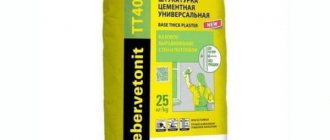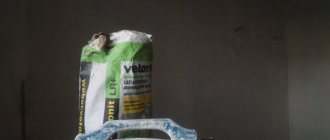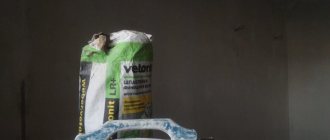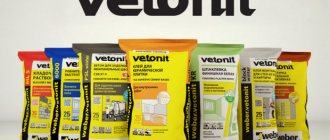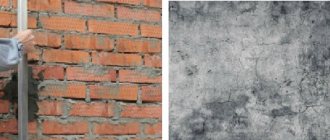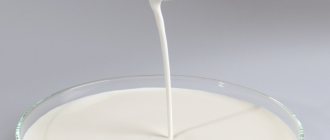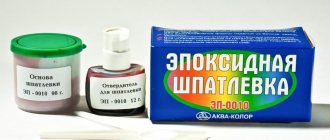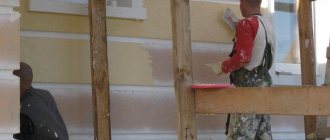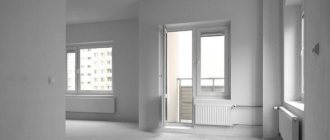Vetonit is one of the types of construction powder mixtures used for finishing and construction work. Excellent quality has made this brand popular. The main purpose is to work at the final stages of leveling surfaces. Vetonit putty can make walls perfectly smooth and hide cracks and cracks.
Example of packaging "Vetonit 25 kg"
The type of mixture depends on the components - gypsum, cement, polymer. They are capable of covering walls and ceilings of various types - plasterboard, concrete, wood, etc.
Most solutions are universal, used for interior and exterior decoration.
Features of the Vetonit brand:
- Natural, environmentally friendly composition;
- Distributes easily, without visible differences;
- The powdery structure makes surfaces smooth and even;
- Sands without problems, leaving no dust;
- Provides additional sound insulation;
- Applied manually or mechanically;
- Economically used;
- Sold in reliable three-layer packaging of 5 and 25 kg.
Kinds
On the building materials market, Vetonit putty is offered by the manufacturer in a large assortment:
- “B” (consists of cement) – for rooms with a high percentage of humidity;
- “VX” (base – cement) – waterproof type, used for processing ceilings and facades;
- “T”, “KR” - used in dry rooms;
- “LR Fine”, “LR+” - for work in conditions of normal humidity;
- “VH” (base – limestone, white cement) – for finishing puttying (concrete, brick, plastered walls and ceilings).
Analogs
Sometimes the average buyer is interested in what can replace the company’s finishing putty so as not to lose in the quality characteristics of the material. Specialists in the field of construction and finishing offer several options for plaster material.
Among them, products from the following brands were especially highly rated:
- Sheetrock;
- Dano;
- Padecot;
- Unis;
- Knauf.
These materials have characteristics similar in quality and application. However, experts note that in an attempt to save money, you can lose quality, because the difference between the analogue and Vetonit will be small. If you choose a gypsum-based analogue, such plaster will not be moisture resistant. Some experts are confident that if you have the skills, you can work with any finishing plaster. Reviews from builders are contradictory, because each master has his own priorities.
Finishing putty Vetonit LR+ (25 kg)
The products are presented on the building materials market in packaging weighing 25 kg. It consists of rare white limestone and high-quality polymer materials.
The putty is intended for leveling surfaces in dry rooms at the finishing stage. It turns yellow with prolonged exposure to moisture, and is applied to clean and treated surfaces of various types.
This is what the manufacturer's packaging looks like
To create the ideal effect, you will need a solid, clean (from dirt, grease) and dry workspace.
By mixing dry Vetonit LR+ with water, a thick, homogeneous white mixture is obtained. The finished composition is used within a day.
The putty is applied in a layer of 1-5 mm. For a large area, 1 mm is recommended, and for a smaller area, 3 mm.
Apply the putty with smooth movements from bottom to top. The room temperature should be maintained from +10 to +30, and ventilation of the room should be ensured.
Specifications
You can prepare and pour the mixture without the use of specialized equipment. Everything is diluted in accordance with the instructions. The mixture consists mainly of cement and various additives. The solutions have excellent adhesive properties, and the maximum shrinkage is only half a millimeter. 20 kg bags have an average consumption of 12 sq.m. The composition is completely environmentally friendly. The finished floor is resistant to moisture and fire. Whether it's the floor in a room, office or bathroom, you will be satisfied. The main thing is not to neglect operational requirements. Let's look at the most popular products in the Vetonit line.
Vetonit 3000 self-leveling floor for heated floors
Superfinish self-leveling floor Vetonit 3000 is a dry mixture based on cement and fine marble. It is used to level the floor covering with a layer of 0-0.5 cm and local repair of cracks up to 1 cm deep. It is applied to a concrete or sand-cement base that has been previously cleaned of all kinds of contaminants. It is afraid of drafts, so it can only be used indoors with normal and high humidity levels. Apply manually, using available means at air temperatures from +10 to +25 °C. The mixture has good adhesion.
Finishing Weber Vetonit 3000 for heated floors
The manufacturer recommends using Vetonit 3000 as a stable base for subsequent laying of the finished floor, but not as an independent unit. The consumption of Vetonit 3000 self-leveling floor is 1.5 kg of solution per 1 sq.m, provided that the layer does not exceed 1 mm.
Important! It dries very quickly - this is the main problem discussed on the forums. Experienced builders advise dividing the area into zones, because the solution hardens after half an hour. And if the area is large, it is better to take someone to help, since you will have to knead a new batch every 20 minutes.
Subsequent manipulations for laying the floor can be carried out after 24-72 hours - depending on the thickness of the differences that were covered by the self-leveling Vetonit 3000.
20 kg per 13 sq.m with a layer thickness of 0.1 cm
The price of the bag is 570 rubles.
- Vetonit 3000 is suitable for laying heated floors;
- for rooms with high humidity levels;
- premises for any purpose;
- quick drying.
- adding more than the required volume of water will lead to cracking of the floor;
- working with it is not easy, the alignment procedure requires special skill, you need to move extremely quickly;
- quick drying does not allow working on large areas;
- Suitable only for surfaces that do not have large differences, maximum 3 mm;
- not suitable for use over gypsum substrates.
Vetonit 3100 for moderate load
Weber Vetonit 3100 is a modernized new product that is used as a finishing, filling, leveling agent. Excludes any coatings other than concrete. It can also be used to seal cracks. Pre-vacuum the surface from dust and remove grease. Floors should be primed in two layers. Begin installation in a hermetically sealed room - three days after flooding, this norm should be observed. If there is a need to level the floor in several stages, after each layer has dried, it will need to be primed again. And fill only after 24 hours.
Vetonit 3100 for moderate load (houses, public buildings)
Self-leveling self-leveling floor Vetonit 3100 is suitable for use in rooms with moderate load, including residential and public. Depending on what you will use as floor covering, you should wait from 3 to 7 days.
Layer thickness, mm
Floor tiles, porcelain tiles
Parquet, laminate, linoleum, carpet
Days
The solution is prepared in the proportion of 4.8-5.2 liters of water per 20 kg or 240-260 g per 1 kg of mixture.
Drying time (technical walkthrough)
1.6 kg per 1 sq.m with a layer thickness of 1 mm
Vetonit LR (25 kg)
Vetonit LR (25) is based on polymeric substances. It is used to cover plastered and concrete surfaces.
The task performed by finishing putty is the treatment of walls/ceilings of various types. It is distributed mechanically or manually. For independent work, choose a wide spatula and use it to adjust the thickness of the layer.
Vetonit LR easily levels surfaces, preparing them for further processing, and is applied in one layer.
This composition is not used for leveling floors and is not used in places with high humidity.
Standard formulations
Classic Weber Vetonit adhesives are intended for cladding floor and wall coverings, traditional substrates, which include seasoned concrete, brickwork, and cement screed.
Depending on the tasks, you can select a product from the adhesive line for a specific finishing material. This condition is important to take into account in order to achieve strong adhesion of the tile to the surface.
Table 1. Features of standard Vetonit Weber adhesives
| Properties/brand | Optima | Easy Fix | Granite fix |
| Masonry adjustment, minutes | 8-10 | 10-12 | 10-15 |
| Vitality, hours | 2 | 2 | 2 |
| Adhesion to tiles, MPa | 0,5 | 0,6 | 0,8 |
| Maximum layer thickness, mm | 10 | Up to 15 | Up to 15 |
| Application temperature, degrees. | From +5 to +30 | +5+30 | From +5 to +30 |
| Consumption, kg/m2 | 1,29 | 1,29 | 1,29 |
Vetonit Optima
The product can be used for interior and exterior work. Universal adhesive is suitable for gluing ceramic tiles and glass mosaics. Before work, the dies do not need to be specially soaked. The composition is characterized by economical consumption, uniform hardening and high strength characteristics; it has good contact with plaster, concrete, and brick bases.
Easy Fix composition
Vetonit Easy Fix tile adhesive provides a strong connection of ceramic tiles, medium format porcelain stoneware fragments with various types of bases. Due to its high resistance to the aquatic environment, the product can be used in rooms with high humidity - bathrooms, baths, saunas.
Frost resistance of the frozen mixture is 100 freezing/unfreezing cycles.
The strong mortar is suitable not only for laying on traditional bases made of concrete, cement or brick, but also on sheets of plasterboard, gypsum fiber, cement-bonded particle boards, cement plaster, gypsum putty, cement-lime base.
Granite Fix
The standard product for tiling porcelain tiles, double-fired ceramics, clinker and mosaic products, Granit Fix has good properties. The elastic texture of the mixture allows for laying on wall and floor surfaces from the street and indoors.
The glue is characterized by high frost resistance (150 cycles), lack of moisture absorption after drying, minimal shrinkage and fluidity. Granite Fix is one of the adhesives in the Vetonit line, which is suitable for lining heated floors and spot gluing insulating materials. The gray solution has very high strength.
Vetonit VH
The properties of this finishing putty are not affected by the humidity factor. Area of use: concrete, brick and facades.
This composition does not adhere to surfaces treated with water-soluble and lime-based products.
Vetonit VX
The wall/ceiling is pre-cleaned of dirt. Preparation of the solution: pour water into a clean container and add putty, beat it with a powerful electric drill for five minutes and let it sit for three hours.
Apply the finishing composition with a standard size spatula using smooth movements. The remaining solution can be reused. If application is carried out in several layers, you should wait for each layer to dry. It takes 2-3 days.
Facade putty is applied in two layers, each of which is no thicker than 3 mm. After drying, imperfections are rubbed off with abrasive materials.
LKMFLOT
Finishing facade putty Weber Vetonit Fasade
Finishing façade putty Weber Vetonit Fasade wholesale!
We are a wholesale supplier of paints, varnishes, sealants, enamels, primers, impregnations and other paint and varnish products.
LKMFLOT is an official dealer of the world's leading brands; we cooperate with manufacturers Alpina, Beckers, Caparol, Dufa, Dulux, Hilti, Tikkurila and others.
We carry out wholesale deliveries of paint and varnish products from a warehouse in Moscow.
We offer special conditions for foremen, architects, painters and other regular customers who buy paintwork materials in batches.
- Huge assortment, more than 300 famous brands
- Delivery to your facility in Moscow and the Moscow region using the company’s own vehicles
- Professional advice from experienced experts
- Tinting using European equipment
- Finishing facade putty Weber Vetonit Fasade
- Lime-cement plaster Weber Vetonit 414
- Cement-based putty Weber Vetonit Reр 970
- Plaster Weber Vetonit TTT
- Plaster Weber Vetonit TT
- Cement plaster Weber Vetonit Cement
- Cement-based putty Weber Vetonit Reр 975
- Finishing putty Weber Vetonit VH
- Plaster Weber Vetonit TT40
—>
| (20 kg) white Winter | wholesale | specify |
| (20 kg) gray | wholesale | specify |
| (20 kg) gray Winter | wholesale | specify |
Code: 100976158
Category:
Putties and Plasters
Brand:
Weber-vetonit
Packing:
20
Packing:
1
Finishing facade putty Weber Vetonit Fasade (Weber Vetonit Facade)
DESCRIPTION: Cement facade putty. For final leveling of surfaces with a thickness of 1 to 5 mm. Color gray or white.
PROPERTIES: - layer thickness up to 5 mm - for interior and exterior use - high adhesion - water and frost resistant
PURPOSE: — final leveling of the surface before painting — cosmetic repairs of concrete and plastered surfaces — application to plastered surfaces
PREPARATION OF THE BASE: The base must be dry, sound and not subject to shrinkage or deformation. The base must be cleaned of dust, dirt, old paint, mortar and degreased. At ambient temperatures above 25°C, it is recommended to moisten the base before applying putty. The temperature of the base and the environment must not be lower than + 5°C. Porous substrates must be pre-treated with weber.prim multi or weber.prim A10 primer (previously diluted 1:4 with clean water).
PREPARATION OF THE MIXTURE: Pour 5.8-6.8 liters of water into a container and add 20 kg of putty (bag). The mixture must be mixed in clean water at a temperature of approximately 20°C. The amount of water depends on environmental conditions and surface porosity. The mixture must be mixed mechanically using a drill mixer at medium speed (400 - 600 rpm) to achieve a homogeneous mixture without lumps. Leave the mixture for 5 minutes to “ripen”, then stir again. After this, apply the putty to the wall using a spatula or trowel, the permissible thickness of one layer is up to 4 mm; greater thickness can be obtained by applying the putty in several layers with intermediate drying of each layer for at least 8 hours. After the putty begins to dry (after 2-3 hours), carefully sand it using an abrasive material. At 20°C and normal humidity, the prepared putty remains viable for at least 2 hours. As the temperature decreases, this time increases, and as the temperature rises, it shortens.
NOTE: While drying, the putty must be protected from high temperatures, direct sunlight and wind. When applying putty for the first time or when environmental conditions change, it is advisable to check and establish the optimal proportion of water and mixture in a small area, but then stick to it very precisely. If there are expansion joints on the base, then when applying the mixture it is also necessary to make expansion joints, repeating their geometry and filling them with polyurethane sealant.
APPLICATION: To apply the putty, you need a narrow spatula measuring 80 - 100 mm and a wider one - about 250 mm wide. To putty walls with large deviations from the main plane, metal rulers are used. The putty is applied to a ruler 2-2.5 m long, evenly “stretched” along it with a small spatula and applied to the wall. This method is effective where there is a need to apply a layer of putty several centimeters thick. Relatively smooth walls can be puttied with a regular spatula without any problems. If you apply a layer from left to right, the upper part of the spatula should be to the right relative to the bottom, if from right to left - to the left. When putting putty from bottom to top or top to bottom, the nature of the movements is similar. The inevitably resulting sagging is smoothed out with a spatula during the subsequent application of putty. The optimal angle of inclination of the spatula to the wall surface is 45-60°C. Changing it leads to a change in the thickness of the applied layer. The corners formed by the walls and ceiling are puttied with a specially designed corner spatula. After applying the putty, it should be allowed to dry, then sanded with abrasive paper or mesh if necessary.
Execution steps
To achieve the desired effect, the surfaces are treated with an acrylic primer.
Prepare the solution, taking into account the consumption - for a layer of 1 mm it is 1.2 kg/m². The contents of the bag (25 kg) are mixed with water (8 l), using a drill with an attachment, taking into account that the powder is poured into the water, and not vice versa. To obtain a homogeneous thick mass, beat for 10 minutes, then leave for 20 minutes and repeat stirring . You can use the prepared mixture at a temperature of +100 for 24 hours.
Execution example
For finishing work, take two spatulas - one 70 cm wide and the second 30 cm wide. The putty is applied in one or two layers, provided that each one is completely dry.
If the room has normal humidity and temperature, there is ventilation, the layer dries in 2-3 days, after which they move on to decorative surface finishing - painting, wallpapering.
White like marble
And now, attention, the first secret. Where does weber.vetonit LR+ putty come from so white? It turns out that it is made from finely ground marble - this is what gives it such a stunning color. Moreover, not just any marble is suitable for it. The necessary material for the Elerka was found only in a quarry in the town of Polevskaya, Sverdlovsk Region, where the Weber-Vetonit plant was built. Before this, the company studied all the marble quarries in Russia and the only one that met all the criteria was on the Polevaya River. What does marble whiteness give? Firstly, there is no need to repaint the putty color before painting and you can save on finishing materials. And, secondly, you can create very impressive decorative finishes using LR+ itself. Well, of course, “marble putty” will perfectly stick to any wallpaper and apply any paints.
Puttying ceiling and wall structures
Vetonit putty has proven itself to be an excellent leveling agent. If the ceiling is rough, it should be cleaned and made perfectly smooth.
Puttying drywall seams
Sequence of actions when repairing the ceiling:
- First, apply a primer suitable for the given surface. Do this carefully, using a roller. Afterwards, all places where the composition came into contact are thoroughly cleaned.
- Fill the bucket with water and pour out the putty, mix with a drill. Using a narrow spatula, transfer the solution onto a wide one, then distribute it over the ceiling area. The first layer is the starting putty, and the second is the finishing layer. The overall result of the repair depends on the quality of application.
- Ceiling sanding.
Wall finishing stages:
- The walls are cleaned of old finishes.
- Cover with primer and wait for it to dry. Cracks and irregularities are plastered. Afterwards, the surface is treated with sandpaper and re-rolled with a primer.
- The number of layers of putty depends on the type of decorative finish. The composition is distributed carefully, with smooth movements from left to right.
- When the putty has dried, it is sanded with sandpaper, then the dust is removed. The wall is primed again before the next layer of finishing putty. After applying it, repeat the sanding and priming steps.
- Start wallpapering or painting.
Application methods
Leveling surfaces using putty can be done in several ways:
- spraying using a special device;
- manual application using different spatulas.
The manual method is often used for polymer putty. There are no strict requirements here; it all depends on the construction tasks and personal preferences. The thickness of the putty layer should not be more than five millimeters, otherwise the coating will dry unevenly and for a long time.
If several layers are applied, then before applying the next layer, you need to wait until the previous one has completely hardened.
Breeding recommendations
The number of types and brands of finishing mixtures is huge. At different stages of leveling, different types are used - starting, finishing.
The rules for preparing the solution are indicated on the packaging; adhere to the manufacturer’s recommendations. Having calculated the consumption, take a bucket, pour the required amount of water into it, add the contents of the bag and knead for several minutes with a construction mixer. Now you can get to work, remembering that the mixture thickens during the day and its elasticity cannot be prolonged; you will have to mix a new one.
Structure
Work technique
For the work you will need an angled spatula, a wide and narrow spatula, a mesh jointer and an abrasive mesh, a plastic work bucket, and a rag.
The working order is like this.
The surface of the wall or ceiling is carefully cleaned. Remove the slightest particles of previous plaster, paint or wallpaper rolls, dirt or grease. Power tools for sanding walls after puttying?
If possible, wash and allow the room to dry thoroughly.
Using a large rule and a flashlight placed next to the wall, mark all the bumps and depressions. The bumps are immediately carefully knocked down, and the pits are outlined with a pencil.
The wall is being leveled. The tools are thoroughly washed and wiped dry with a clean, lint-free rag. The mixer for construction work must also be clean, without adhering remains of the previous mixture. Knead the paste-like mixture.
Important : you cannot add water or dry putty to the finished paste.
Apply a similar amount of paste to a long spatula, which can be used in one stroke.
Cracks, depressions and pits are covered with a long or medium-sized spatula using sweeping movements with equal pressure. Grouting is done until the putty is flush with the wall , without sagging.
It is important to choose a good spatula. Drying is performed with the interior doors open. Acrylic varnish for walls: how to apply video? In this case, balcony doors, entrance doors, to the bathroom or kitchen must be closed.
Additional equipment cannot be used.
It is enough to apply putty under the rolls of wallpaper for starting work to seal all the irregularities. The wall is leveled “to zero” so that there are not even the slightest depressions or humps.
For painting, after grouting the starter, use it as a finishing putty. It is applied in a thin layer and, after drying, rubbed down with an abrasive material with a number of 150 or more. Under mirror painting, they are additionally passed with a trowel with suede.
Slopes and corners are smoothed using an angle spatula.
The consumption of Vetonit final putty is approximately 20-25 kg per area of 45-50 square meters.
Here are the opinions of real clients
Vetonit putty is popular. It is easy to apply, lays down softly, and should not dry out in the bucket. The only thing is that the workers urge to be careful with the further primer mixture and the use of wallpaper glue. Putty is afraid of moisture.
Below are real customer opinions:
Excellent quality putty, we are doing renovations in the bedroom and decided on this option - the seller in the store recommended Weber Vetonit. I liked that it was much easier to work with; my husband diluted it in a bucket of water (keeping the proportions right!) and mixed it by hand. I was pleasantly surprised that the prepared solution stood in the bucket and did not dry out for several days (it was carefully wrapped in polymer ethylene), and throughout this time it remained flexible, which is extremely convenient for home repairs; there is no need to prepare it every day.
Perform basic surface leveling
Prepare the solution according to the instructions: the weber.vetonit TT from a 25 kg bag into a bucket with 5-6 liters of clean water, mix for 3-5 minutes using a drill with an attachment, let the solution sit for 10 minutes and mix again.
After this, we apply the plaster mixture to the surface manually using a steel spatula or mechanically. Each layer of weber.vetonit TT dries within 1-2 days, and the next layer of plaster can be applied only after the previous one has completely dried. In dry conditions, it is recommended to moisten the leveled surface with water from a spray bottle.
After completing the leveling process, treat the dried surface with sanding paper and remove dust.
Note that if we are talking about smooth walls or ceilings made of plasterboard slabs, then the stage of treating the walls with plaster can be skipped and you can immediately begin treating the surface with white finishing putty.
Weber Vetonit LR putty: consumption, reviews, properties
Weber Vetonit LR putty: consumption, reviews, properties
When finishing putty is required, people most often choose products from Weber, whose popular product has become a mixture marked Vetonit LR. This finishing material is intended for interior work, or more precisely, for cladding ceilings and walls. But putty alone is not enough to create a high-quality coating. The process of its use has many nuances, which everyone who decides to use Weber Vetonit LR putty should know about.
Weber Vetonit LR putty: consumption, reviews, properties
Peculiarities
Vetonit LR putty composition is a product for the final leveling of fencing structures. It is a mixture for plaster on an adhesive polymer base, which is intended for cladding dry rooms. This is a fine-grained powder material that is sold in 25 kg bags. The mixture is a semi-finished product because it needs to be diluted with water right before application. It has a white base color, which makes it possible to change the shade of the plaster coating at the request of the customer. In no case should it be used when decorating a facade, because the composition is not designed to withstand exposure to weather factors and moisture. It is the composition of the product that does not make it possible to use the mixture on bases that can deteriorate. It cannot be used to decorate wooden houses, which shrink during use. This putty cannot be used in apartment buildings with high levels of humidity. In such conditions, it will begin to absorb moisture from the outside and peel off from the base, which will be accompanied by chips and cracks.
Due to the low level of resistance to evaporation and moisture, the material cannot be used in all rooms. For example, it is not applicable in the kitchen, bathroom, sanitary unit, loggia or glazed balcony. Condensation is the worst enemy of putty. At the moment, the manufacturer is trying to solve this problem by producing modified types of LR putty. Unlike them, it is made of polymers and is also intended for concrete and plastered bases. A distinctive feature of the material is the different number of application layers. For example, LR is applied in 1 layer, and therefore multi-layer complex decorative coatings are not produced from it, because this affects the operational durability, despite the quality characteristics of the raw materials. It will not be able to level out huge differences - the composition is not created for such work. The manufacturer recommends using it for plasterboard, cement, gypsum and cement-lime bases.
